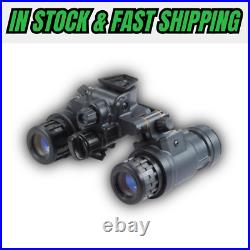


The AN/PVS-31A is one of the most compact and lightweight goggle on the market. This unit has a plethora of features such as independently pivoting pod design that allows the end user to rotate the pods away from the center, It also features a individual cut off which cuts power to the image intensifier by flipping the the unit up on the mount, and runs off a single AA battery up to 16 hours of use. We offer customers the option to view our. You will be able to view images through the unit, the specifications for the unit, and be able to select the one that works for you. If you have questions, or don't know what will work for you, you can always chat with us in our live chat, or give us a call and we would be more than happy to figure out which system will best fit your specific needs.
One AN/PVS-31A Night Vision Goggle; bikini covers; Soft bag; battery pack and cable; accessory kit; spec sheets. Our AN/PVS-31A Goggle White Phosphor will come with a minimum FOM of 2376+.
Image Intensification tube specification designation, calculated on line pair per mm x signal to noise. The ability of an image intensifier or night vision system to distinguish between objects close together. Image intensifier resolution is measured in line pairs per millimetre (lp/mm) while system resolution is measured in cycles per miliradian. For any particular night vision system, the image intensifier resolution will remain constant while the system resolution can be affected by altering the objective or eyepiece optics by adding magnification or relay lenses.
Often the resolution in the same night vision device is very different when measured at the centre of the image and at the periphery of the image. This is especially important for devices selected for photograph or video where the entire image resolution is important. Measured in line pairs per millimetre (lp/mm). SNR (Signal to Noise Ratio).
Because SNR is directly related to the photocathode's sensitivity and also accounts for phosphor efficiency and MCP operating voltage, it is the best single indicator of an image intensifier's performance. This is the amount of light you see through a night vision device when an image tube is turned on but no light is on the photocathode. EBI is affected by temperature; the warmer the night vision device, the brighter the background illumination. EBI is measured in lumens per square centimeter (lm/cm2). The lower the value the better.
The EBI level determines the lowest light level at which an image can be detected. Below this light level, objects will be masked by the EBI. Halo is the circular region around a bright light that appears "brighter" - It's caused by elastic collisions of electrons with the MCP surface which subsequently then bounce off and down another hole. Halo's are the same size all over the screen and the size is dictated by the distance between the photocathode and the MCP. Basically, it's the round circle around lights when you look at them with Night Vision and it's generally used as an indication that you're looking at something that's too bright. Photocathode sensitivity is a measure of how well the image intensifier tube converts light into an electronic signal so it can be amplified. The measureing units of photocathode sensitivity are micro-amps/lumen (µA/lm) or microamperes per lumen.
Also called brightness gain or luminance gain. This is the number of times a night vision device amplifies light input. It is usually measured as tube gain and system gain. Tube gain is measured as the light output (in fL) divided by the light input (in fc). This figure is usually expressed in values of tens of thousands.
If tube gain is pushed too high, the tube will be "noisier" and the signal-to-noise ration many go down. Military Gen 3 image tubes operate at gains of between 20,000 and 45,000.
Therefore, system gain is a more important measurement to the user. Approximately 16+ hours of battery life on a AA battery. 450 g (15.9 oz).


